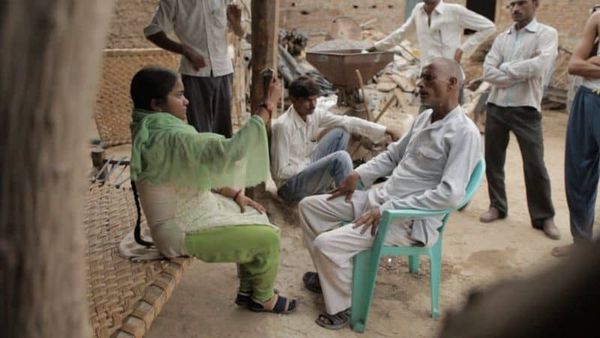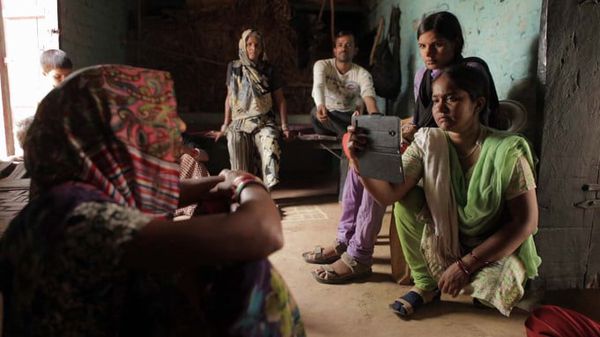 |
| Sushmit Gosh: 'They’ve really changed the framing of language around what a Dalit women woman can do, or what she looks like' Photo: Courtesy of Sundance Institute |
Rintu Thomas: I think it depends on where you grew up. And of course, class has a contributing factor to that. In the cities, for instance, both our families - my family is from Kerala - Sushmit's from West Bengal, our parents, in search of upward mobility, moved from their villages and towns and came to the big city of Delhi. In a city, it's porous, right, you don't really realise, because it's more cosmopolitan people of different religions, and castes are studying together. So honestly, when I was growing up, I wasn't really aware of the caste system, but it's in the fabric of our lived realities. So for example, back home, in Kerala, there would be people who would come to do chores, for example, or friends of the family, some people would not arrive from the, you know, the main living room or the courtyard, they'd come in from behind the kitchen. And, and, you know, so and these people would always stay in that area. So you'd wonder, or you would accept that, it's much later in life, you realise what was going on.
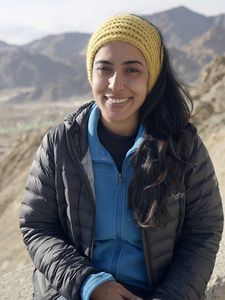 |
| Rintu Thomas Photo: Courtesy of Sundance Institute |
So when you came across this story, were you quite surprised yourselves to discover this story of these Dalit women basically doing it for themselves, irrespective of any kind of system?
Sushmit Gosh: Yeah, I mean, what we were surprised about was that they've been around for 14 years and we hadn't heard of them. And ironically, we discovered them through this very beautiful sort of stop-motion piece that a photographer had done on the internet. To frame it, Uttar Pradesh is the largest state in India, it has more than 200 million people living there. It is the most significant state for any political party in India to win the elections in. So this whole idea of the rise of the Hindu right and also caste, essentially, are enmeshed in up. So when we found out about their area, our curiosity was piqued. And we got really lucky because we reached out to them at a time where they were just about to make this transition to digital. And that was what was interesting for us because, you have these very different forces sort of just from a storytelling point of view - you have 3000 years of baked-in patriarchy and a social system that is meant to keep you out on one hand. And on the other hand, you have the unfettered power of the internet and the digital and technology coming together. And that's how we sort of started following this story. Honestly, out of curiosity, just to see what was going to happen, we have no idea that it would turn out to be such a massive success as a newspaper and as a digital news agency right now.
In the last year, I think we've all become even more aware of the sort of power of the internet. I think people often forget just how democratising it is as a as a tool, because obviously, anybody more or less can access it somehow. I think that really comes across in your film, the idea of the internet being a leveller to some degree for these women.
I wonder if being considered by society to be the lowest of the low, in a way gives these women a fearlessness in that, if everybody thinks you are at the bottom, then the only way is up to a degree. So it's not a case of being a victim – it’s being fearless in the face of prejudice.
RT: Yeah, and that's very attractive, that sense of, I'm here, and because I'm here this is getting done. If not me, then who else? If not, now, then when else? That's the kind of response that we've also seen from male journalists. In the field, they just don't know how to respond to the camera, people in power. There is, of course, a lot of mansplaining - you know, ‘You should do it like that’, that kind of patronising thing. And they're straddling both worlds with a matter of fact panache.
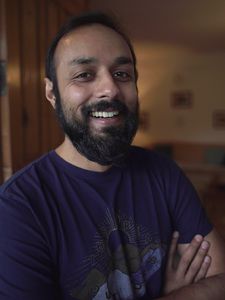 |
| Sushmit Gosh Photo: Courtesy of Sundance Institute |
I mean, for instance, I mean, we, we've been filming, like we've been filmmakers since 2009 and worked all across the country. But in these parts, I mean, the kind of trauma that we witnessed on a daily basis, the kind of violence that we saw on a daily basis, literally shook us. And, you know, we'd ask them, ‘How do you deal with this, because every day you reporting on a story of either rape or mutilation of murder’ - and this isn't just a murder, these are brutal killings. And they were like, you know, ‘It's not something new. This is something that we've grown up with, these are stories that have been there in our families, in our communities, it's new for you, that’s why it’s shocking.’.
It's like you said, you have your back against the wall, you have nowhere else to go - the only way is forward. The early scene in the film where you see Meera pitching, this idea of shifting from print to digital was actually our first day of filming. Way back in 2016. And one of the things that she'd said, which is, which is not there in that cut is,’We have no other choice, we have to do this, because they were doing about 5000 runs of the physical newspaper every 15 days. And she said at most, you will have 5000 readers multiplied by three, because the newspaper would get shared as much. And most of the people consuming the news are men. If you diversify and move to the internet, you're not only looking at a large target group, but you're also looking at an interesting demographic and you including women in this conversation. And so I think that they've really changed what it means being a Dalit woman in those parts. And the last time we went to film like one of the things that we both came back with was this a lot of respect for them coming from quarters where four years ago, we saw a lot of dismissiveness.
When you first came to the story, were they welcoming of having you sort of with them, because obviously, some of these things that they're doing are dangerous, some are very sensitive, when they're talking to say victims of violence. Did they embrace you from the start?
RT: I think our process was to just be there, and observe and let them become comfortable with the idea of us being there. So we weren't filming from day one, we sort of hung out a lot and had lots of conversations, because they were just discovering the power of being in front of the camera and behind the camera, as we were present. What really helped was us spending time with them and developing that trust. Initially, like after the first recce shoot of seven days, Meera was like, ‘Are you guys done? When is the film coming out?’ Because they were used to being profiled by, you know, different filmmakers in their shorts. But by the end of the first year, they were just like, I think, just bored of our presence Eventually, the concern was, how are we going to be represented? They are going to be delicate things, risky things, how are we going to work together? And those are conversations that we had very early on where we said, ‘We're going to come with a stripped down crew’, it was just the three of us, both of us and our co cinematographer. So the idea was just to move like a single organism in a way with the reporters. And if there were delicate things that they didn’t want us to film, we wouldn’t. So once we started working in the first six months, is when they got really comfortable, and then invited us into their homes. And that's when the story started really falling into place.
Does it help that you’re a married couple as well in terms of both being accepted by the women and the understanding between you as you’re working?
RT: Oh, yes, there's a there's a very inherent credibility that comes with it and also the depth of conversations. Because there are three women in three different stages of their lives, and everyone had a relationship.
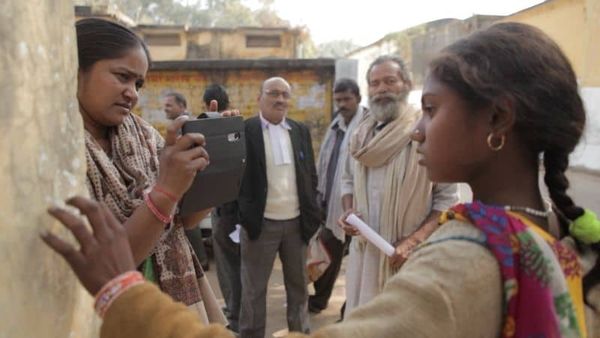 |
| Rintu Thomas: 'I think our process was to just be there, and observe and let them become comfortable with the idea of us being there' Photo: Courtesy of Sundance Institute |
Away from the domestic side of the film, the political side of the film regarding Narendra Modi and the Hindu right is also strong.
SG: I think I think the film, for us, took a big turn in 2017, when Yogi Adityanath was elected, the chief minister of Uttar Pradesh, and things really began to change on the ground. Uttar Pradesh was the petri dish for what would eventually happen in India in 2019. So, and Satyam, for us became that very symbolic character of what can go wrong. Even now, when we talk about him, we he's not like black or white for us. He's a very grey character, a very likeable young man in a weird way, just like anybody else, right, but philosophically, obviously, aligned to the right. And, with him coming into the film at the halfway mark, the film completely changes and becomes something else, which helped us look at Khabar Lahariya’s larger body of work, which is beyond the grassroot level initiatives, right, it was much more scaled up. And it spoke to how they were talking as journalists about what was happening in India politically and reporting from the frontlines, so to speak, because those are the parts of India where it's really difficult to be critical of the system. I hope that we are able to sort of bring the film back into Uttar Pradesh and screen it across communities, across villages. That's the dream, for more Indians to be able to see this film to be able to witness the power of what essentially the Fourth Estate can do and is meant to do. I think I think the essence of any healthy, vibrant democracy is a free press. And for us Khabar Lahariya represents that. And added to that the fact that it's free press led by Dalit women. So it challenges notions and stereotypes in every possible way.
Do you keep in touch them, I was wondering how they're doing now because presumably they are covering the Covid situation, quite extensively?
RT: 2020 was their busiest year because India had at one of the most toughest strictest lockdowns where an entire country was shocked with four hours’ notice, which meant that all the migrant populations who are in cities needed to go back home, but there was no means to, the whole country was shut. So thousands and thousands of people started walking back to their villages, 600 kilometres, 1000 kilometres, some, of course, even lost their lives in the middle. So the ones returning to Uttar Pradesh, actually, it is the Khabar Lahariya journalists that became a linkage between their families and what was happening to them, and the State administration. So they were of hugely vital link and they did a lot of collaborations because they have their ear to the ground, a lot of other news outlets couldn’t travel. So that was busy and risky. But this is this is like unprecedented. The second wave is a lot more virulent than the first one. So the reporting has become limited. They're adapting. They're so smart. They're constantly adapting.
For more information about the film, visit their Facebook page








